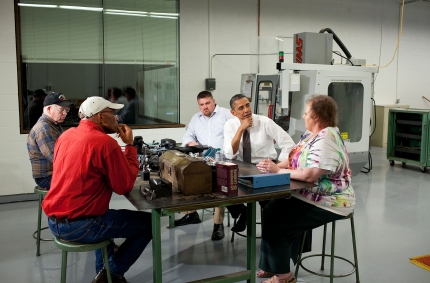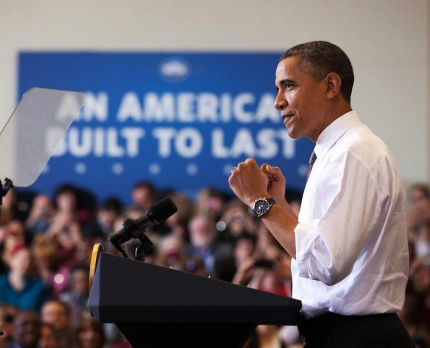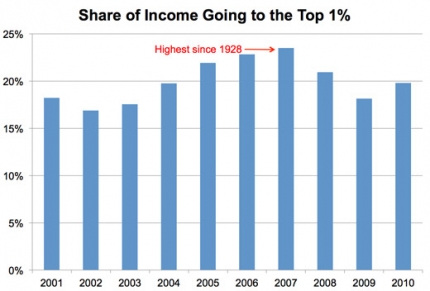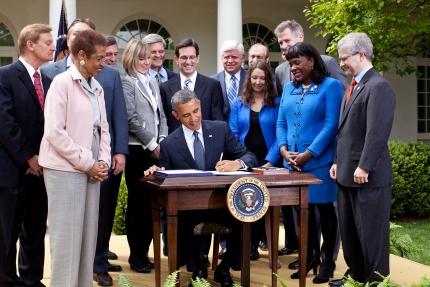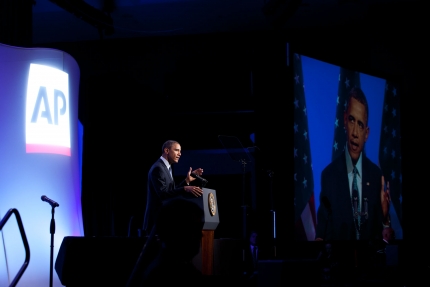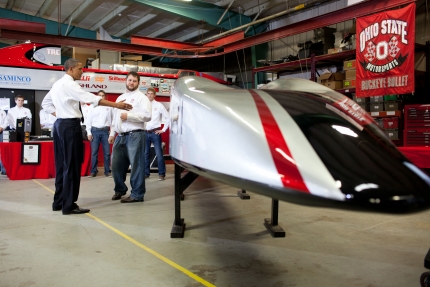Jobs News
NASA Reaching for New Heights
Posted by on April 20, 2012 at 6:00 PM ESTIn his gloomy Washington Post commentary today on yesterday’s ceremony transferring ownership of the Space Shuttle Discovery from NASA to the Smithsonian’s National Air and Space Museum, Charles Krauthammer urged readers to think of that transfer as the funeral for U.S. leadership in space. Nothing could be further from the truth. The United States remains far and away the world leader in space technology and exploration. As long as appropriate support continues to be forthcoming from Congress, this will remain the case indefinitely.
Krauthammer suggests that if China succeeds in putting astronauts on the Moon by 2025, as that country plans, they will have “overtaken” the United States. How absurd! Neil Armstrong and Buzz Aldrin walked on the Moon in 1969. How does China managing this feat fifty-six years later, if this happens, amount to “overtaking” us? Obviously, the United States could repeat its lunar feats of the 1960s and 1970s if that were the next most important thing to do in space exploration for the money. But it isn’t! We may well return to the lunar surface again as one of many destinations in the future, but for now, our immediate, more scientifically rewarding goals include sending astronauts to an asteroid in the 2020s, and Mars in the mid-2030s. They bring scientific and technological challenges worthy of a great nation and a true world leader.
Krauthammer doesn’t even mention the International Space Station. The United States led the planning, design, and construction of this $53 billion marvel – an orbiting science and technology-development laboratory that has been continuously manned since 2000. Under the previous administration’s plan, it was underfunded after 2016, implying intent to abandon it long before its scientific and engineering potential had been realized. Under the new bipartisan space-exploration plans worked out between the Obama Administration and the Congress, we will continue to operate the Space Station until at least 2020 and perhaps beyond.
In robotic space exploration, too, nobody else comes close. At this very moment, a stream of data is flowing to us from missions orbiting the Sun, Mercury, the Moon, the asteroid Vesta, Mars, and Saturn. We now have missions on the way to Jupiter, Pluto and Mars. The Hubble, Spitzer, Chandra, and Fermi space telescopes continue to make groundbreaking discoveries on an almost daily basis. We’re on track in the construction of the James Webb Space Telescope, the most sophisticated science telescope ever constructed to help us reveal the mysteries of the cosmos in ways never before possible. Last year, the MESSENGER spacecraft became the first-ever to enter orbit around Mercury. And shortly thereafter, the Ebb and Flow satellites began orbiting and mapping the gravity field of the Moon.
Learn more about Education, TechnologyAmerican Business Leaders Speak Out about the Jumpstart Our Business Startups (JOBS) Act
Posted by on April 20, 2012 at 2:35 PM ESTOn April 5, 2012, President Obama signed the Jumpstart Our Business Startups (JOBS) Act, a bipartisan bill that will allow Main Street small businesses and high-growth enterprises to raise capital from investors more efficiently, encouraging small and young firms across the country to grow and hire faster.
The JOBS Act is a product of bipartisan cooperation, with the President and Congress working together to promote American entrepreneurship and innovation. It will help growing businesses access financing while maintaining investor protections, and includes all three of the capital formation priorities that the President first called for last fall: allowing “crowdfunding,” expanding “mini-public offerings,” and creating an “IPO on-ramp” consistent with investor protections.
BUSINESS ASSOCIATIONS
Michelle Long,Executive Director of the Business Alliance for Local Living Economies (BALLE)
“Previous laws placed huge restrictions on the investment choices of small, ‘unaccredited’ investors—a category in SEC that included all but the richest two percent of Americans. The old regulations prohibited the average American from investing in any small business, something that we now expect to be enthusiastically greeted by both business owners and investors across the country.”
Learn more about Economy, Startup AmericaTurning the Unemployment Program into a Reemployment Program
Posted by on April 19, 2012 at 4:15 PM ESTEd note: this post was originally published on Work in Progress, the Department of Labor's blog
Two months ago, the President signed the Middle Class Tax Relief and Job Creation Act of 2012. That legislation extended the vital payroll tax cut and federal unemployment insurance programs that have been so crucial for American families and to the continued and sustained economic recovery. But it also included several important reforms to the Unemployment Insurance system that didn’t grab the headlines the day it passed.
The Obama Administration is committed to finding new and innovative ways to turn the unemployment system into a reemployment system. States, as laboratories of democracy, can play a crucial role in developing creative strategies that help us accomplish this goal in ways that may inform the policies of other states and the federal government in the future.
Today, I had the privilege to announce guidance to states interested in developing demonstration projects to help their unemployed obtain jobs faster and more efficiently. These demonstrations are a key component in the first major overhaul of the Unemployment Insurance system in decades.
Through this initiative, 10 states will have the opportunity to develop new and creative ways to help recipients of UI funds get back to work faster. These states will design programs that help the unemployed get back to work, while lowering costs and ensuring that all participants receive the same worker protections. This will create a level playing field for employers who follow the rules and have their employees’ welfare in mind.
The Labor Department is preparing to announce more guidance in the coming months that further improve the functionality of the UI system. These reforms will provide states with more flexibility to respond to changes in the economy, provide employers tools to avoid layoffs, help the unemployed get back into the workforce faster and even expand opportunities for the unemployed to start their own businesses.
Learn more about , EconomyRegional Roundup: President Obama Travels to Ohio to Promote Job Training
Posted by on April 19, 2012 at 11:00 AM ESTYesterday, the President visited Lorain County Community College in Elyria, Ohio to highlight how federal job training funding is providing critical services for unemployed workers and helping them to get jobs in high-demand, high-growth industries. The President sat down with students in the college’s Transformations program for Computerized Numerically Controlled Machining, a program with a proven track record of success – placing more than 90 percent of participants in jobs within three months of graduation.
If Republicans in Congress had their way, they would actually cut funding to programs that help middle class families get back on their feet in order to provide more tax cuts to the wealthy. That doesn’t make any sense.
- Their proposed cuts would reduce funding for federal employment and training programs to help laid-off and out-of-work adults–eliminating services to 425,000 Americans in 2013, and nearly 1.1 million in 2014.
- Across America, in 2013 an estimated 13,000 young people and 45,000 in 2014 would also lose employment and training services, and job search assistance services would be eliminated for over 1.4 million job-seekers in 2013 and 3.5 million in 2014.
On Board with the First Lady: Michelle Obama Celebrates One Year of Joining Forces
Posted by on April 19, 2012 at 10:25 AM ESTGo behind the scenes as First Lady Michelle Obama travels from Washington DC to Philadelphia, New York City, Shreveport and Jacksonville to honor our servicemen and women and their families. Join us on set at the Colbert Report, on stage with Ellen DeGeneris and on the ground with thousands of nurses and meet the 50,000 person to get a job through the Joining Forces hiring initiatives.
See more:
- View a gallery of the Anniversary events
- See highlights from the first year of Joining Forces in a video or photo gallery
President Obama Talks About Investing in Training American Workers
Posted by on April 18, 2012 at 5:34 PM ESTPresident Obama was in Elyria, Ohio today where he met with students at Lorain County Community College. The President was there to talk about the Administration’s job training initiatives to help more Americans get back to work and connect unemployed Americans with the skills training they need to find jobs in high-demand, high-growth industries, including the Community College to Career Fund. He told the students that taking classes at community colleges and getting new skills doesn't just benefit students and their future employers but adds economic value to the entire region:
Investing in a community college, just like investing in a new road or a new highway or broadband lines that go into rural communities, these investments are not part of some grand scheme to redistribute wealth. They’ve been made by Democrats and Republicans for generations because they benefit all of us. That's what leads to strong, durable economic growth. That's how America became an economic superpower. That's how we built the Transcontinental Railroad. That's why we’ve got the best universities and colleges in the world. That's why we have cutting-edge research that takes place here, and that then gets translated into new jobs and new businesses, because somebody did the groundwork. We created a foundation for those of us to prosper.
When you take classes at a community college like this one and you learn the skills that you need to get a job right away, that does not just benefit you; it benefits the company that ends up hiring and profiting from your skills. It makes the entire region stronger economically. It makes this country stronger economically.
In this country, prosperity does not trickle down; prosperity grows from the bottom up. And it grows from a strong middle class out. That’s how we grow this economy.
Learn more:
Guest Post: Through Crowdfunding New Businesses Can Test Ideas with the Toughest Critics -- Customers and Investors
Posted by on April 18, 2012 at 11:43 AM ESTTwo weeks after the Haiti earthquake, Anna Stork and I teamed up to start LuminAid Lab out of a shared belief that portable solar lighting could greatly add to the safety and survival of victims of a disaster or crisis. As students and novice entrepreneurs, we faced the 'chicken-and-egg' problem that many small companies confront in scaling up a business without an initial, deep source of cash. We had designed an innovative solar light that would help in aiding disaster relief victims, but we lacked the funding to manufacture our product at a meaningful scale.
We launched our company in January 2011, and last November we launched our "Give Light, Get Light" crowdfunding campaign on a donation-based website, IndieGoGo.com. We established a goal of financing the manufacturing of our first 1,000 lights through the pre-sale of 500 lights. The remaining 500 lights would be donated to partners who offered to field test the product.

To our surprise, we reached $10,000 within the first week of the campaign and over the next 30 days, we raised more than $50,000, sold 1,500 lights, and had another 3,300 matched to our partners as donations. While we had field tested several dozen lights and continued to optimize our prototype prior to the campaign, we had not anticipated this type of support and call to action from those who participated by sponsoring lights. These donated lights have been sent to schools, orphanages, and development projects around the world.
Crowdfunding provided us with access to our first 1,200 customers, individuals and organizations with whom we now communicate constantly as a result of their pre-purchase of the LuminAID light. While the money gained from the successful campaign was a big financial boost to our efforts, the even more valuable outcome of the campaign was establishing a connection with the first and earliest supporters of our company. We leveraged crowdfunding as a platform that bridged the gap between testing our idea and truly understanding what motivated our first customers to purchase our product. We are carrying forward this knowledge of what our customers care about as we scale our marketing, sales and distribution efforts. Crowdfunding also allowed LuminAID Lab to engage technology and social media in launching our business and ultimately enabled us to sell our light to people in more than 25 different countries.
It was an honor to have been invited to represent LuminAID Lab at the signing of the JOBS Act at the White House in early April. Provisions of the JOBS Act will allow small businesses like ours greater access to investor capital through crowdfunding – not just donations, but true investments. Our own experience illustrates the value of establishing crowdfunding as a viable source of funding – it will enable new businesses to truly test out ideas amongst the toughest and most thorough critics: the very first customers and investors who share a part in a company's failure or success.
Learn More about the JOBS Act:
- New Law Opens Possibilities for our Growth
- JOBS Act Will Help Disruptive Innovation Emerge in Healthcare
- Ask an Entrepreneur: What's Crowdfunding?
Learn more about Economy, Startup AmericaThe Health Care Law is Helping Small Businesses
Posted by on April 18, 2012 at 8:32 AM ESTSmall businesses are the engine of the American economy. Over the past 17 years, they have generated 65 percent of all net jobs and today the 27.5 million small businesses in the U.S. employ about half of all private sector workers.
The Affordable Care Act is helping fix a health care market that has been broken for small business owners. For too long, many small businesses couldn’t afford to provide coverage for their employees. And those who did paid more and knew their premiums could skyrocket if one employee got sick. For many business owners, this meant choosing between keeping their employees covered or dropping coverage and running the risk of losing good employees.
The new health care law is giving business owners new resources and options to cover their employers. The law helps small business owners by providing tax credits to help them afford coverage. These tax credits have already benefited an estimated two million workers who get their insurance from an estimated 360,000 small employers. This includes businesses like Vahallan Papers in Lincoln, Nebraska. Vahallan Papers has produced custom, hand-made wallpaper for 14 years, and seven years ago, started offering health insurance to attract high quality employees. They were able to get the tax credit in both 2010 and 2011, and used that tax credit to increase the amount they contributed to their employee’s health care costs, saving their employees around $400 a year each.
Learn more about Economy, Health CareGuest Post: The JOBS Act Opens New Possibilities for the Growth of our Business
Posted by on April 17, 2012 at 12:10 PM ESTMy company, Emmy's Organics is three years old. I started it with my life and business partner, Ian Gaffney. We make and manufacture gluten free and vegan snacks and desserts. We literally have grown Emmy's from the ground up, starting in Ian's mother's home kitchen and now working out of our own manufacturing facility in Ithaca, NY. After making use of the first small business loan we took out from our local credit union, we decided to launch a crowd-funding campaign through a donation-based website. We raised $15,000 in 30 days. Over the next 11 months, we used that capital to hire a designer and create custom packaging that was pre-printed and also compostable (our company uses almost no plastic in all of our packaging). We launched our new packaging in December 2011 and in that short time, we have seen a 150% increase in our sales, our products are now available in 1,000 stores and our company has grown from four to seven full time employees. Truly a success.
 The best part of crowdfunding was the experience of our local community supporting us. We have always been and continue to be very community-based. We are proud to label our business as "made in Ithaca, NY" and we use as many local resources as possible. It was such an acknowledgement to us that our fans and neighbors were willing to contribute their dollars to take our business to the next level.
The best part of crowdfunding was the experience of our local community supporting us. We have always been and continue to be very community-based. We are proud to label our business as "made in Ithaca, NY" and we use as many local resources as possible. It was such an acknowledgement to us that our fans and neighbors were willing to contribute their dollars to take our business to the next level.Earlier this month I had the honor of attending President Obama’s signing of the Jumpstart Our Business Startups (JOBS) Act. As I write that, I almost cannot believe it. I would have never thought, back when I started my company that I would be recognized by the White House as an entrepreneur and asked to be a part of history. As I am twenty-five years old, you can probably guess that I have never owned or operated a business before this one. This experience continues to teach me lessons as I continue to grow and develop myself alongside my business. Being at the White House and having the opportunity to speak with government officials, members of Congress, and successful entrepreneurs was a reminder that truly anything is possible.
Both in the immediate and longer term, the JOBS Act opens new possibilities for the future growth of our business. With its emphasis on crowdfunding as a way to raise capital – not just donations but for the first time true investments -- I am excited for other businesses to have that same experience.
Learn more about the JOBS Act:
- Through Crowdfunding New Businesses Can Test Ideas with the Toughest Critics -- Customers and Investors
- JOBS Act Will Help Disruptive Innovation Emerge in Healthcare
- Ask an Entrepreneur: What's Crowdfunding?
Learn more about Startup AmericaSecuring Equal Pay
Posted by on April 17, 2012 at 11:25 AM ESTToday – Tuesday, April 17 – is Equal Pay Day, which marks the fact that, nearly 50 years since President John F. Kennedy signed the Equal Pay Act of 1963, the average woman still has to work well into the calendar year to earn what the average man earned last year. According to the latest U.S. Census statistics, on average, full-time working women earned 77 cents to every dollar earned by men, and the gap is significantly more for women of color. This substantial gap is more than a mere statistic. It has real-life consequences. Women, who compose nearly half of the workforce, are bringing home 23 percent less than their male counterparts – which means less for families’ everyday needs, less for investments in our children’s futures, and, when added up over a lifetime of work, substantially less for retirement.
President Obama understands how much this issue impacts our nation’s economic well-being, and that’s why, from his earliest days in office, he has been committed to closing the pay gap. Today, in conjunction with Equal Pay Day, we are proud to announce the following additional initiatives:
- First, the White House released the Equal Pay Task Force Accomplishments Report: Fighting for Fair Pay in the Workplace. The Equal Pay Task Force (“Task Force”), which the President established in 2010, brings together the best expertise of professionals at the U.S. Equal Employment Opportunity Commission, the Department of Justice, the Department of Labor and the Office of Personnel Management, who work daily to combat pay discrimination in the workplace. Since the Task Force’s creation, enforcement actions have increased; the government has recovered unprecedented monetary recoveries for women seeking their fair share for performing the same work as men; and investments in outreach to both employers and employees are paying big dividends. The report details the significant progress that the Task Force has made to fight pay discrimination – including improving inter-agency coordination and collaboration to ensure that the full weight of the federal government is focused on closing the gender pay gap once and for all. I commend the professionals who represent the member agencies on the Task Force for the extraordinary work they and their teams undertake each day to realize the President’s directive.
- Second, Secretary of Labor Hilda L. Solis today announced the winners of the “Equal Pay App Challenge.” In January of this year, the Department of Labor, in conjunction with the Equal Pay Task Force, launched this challenge – inviting software developers to use publicly available data and resources to create applications that provide greater access to pay data organized by gender, race, and ethnicity; provide interactive tools for early career coaching or online mentoring; or provide data to help inform pay negotiations. A solution to the pay gap has been elusive, in part because access to basic information – e.g., typical salary ranges and skill level requirements for particular positions, advice on how to negotiate appropriate pay – is limited. Because of the enthusiastic response to the “Equal Pay App Challenge” and the creative apps that were developed, anyone with a smartphone, tablet or computer can access answers to these basic, but important, questions. This challenge represents just one more way that women can empower themselves with the tools they need to make sure they get equal pay for equal work.
- Finally, in our ongoing effort to educate employees and employers about their rights and responsibilities under our nation’s equal pay laws, the Department of Labor today published two brochures that will educate employees regarding their rights under the existing equal pay laws and enable employers to understand their obligations.
60,000 Veterans and Military Spouses Have Been Hired Through Joining Forces Employment Initiatives
Posted by on April 13, 2012 at 2:34 PM ESTIt was a great day in Shreveport, Louisiana, yesterday. First Lady Michelle Obama joined the leadership of the Kansas City Southern (KCS) Railway Company in announcing Michael Abitago, Junior as the 50,000 veteran or military spouse to have been hired by a company through the Joining Forces employment efforts this past year! Abitago literally left active duty in the Army last Saturday after 4 years of service (including 2 tours in Iraq) and starts work on Monday as a Conductor-trainee. He was hired by KCS in mid-March at a Joining Forces hiring event in Ft Hood, Texas.
And there’s even more great news. A couple of months ago when we first wanted to highlight this event, we had planned on announcing our 50,000 hire. But as we approached our visit to Shreveport we had already hit that mark. By April another 8,000 veterans and military spouses were hired. And yesterday, Mrs. Obama revealed the news that the surge in hiring pushed the number of veterans and military spouses hired through Joining Forces to 60,000!
Through Joining Forces, American businesses have not only hired more than 60,000 veterans and military spouses to date, they have also pledged to hire at least 160,000 more in the years ahead.
More than 1,600 companies have been involved in this effort, including Microsoft, Comcast, Honeywell, Safeway and Sears. JPMorgan Chase and the 40 companies of the “100,000 jobs mission” hired more than 6,000 veterans -- alone – in the January-March 2012 timeframe.
President Obama’s Record, Results and Agenda on Income Inequality
Posted by on April 13, 2012 at 8:00 AM EST“This is a make-or-break moment for the middle class, and for all those who are fighting to get into the middle class. Because what’s at stake is whether this will be a country where working people can earn enough to raise a family, build a modest savings, own a home, secure their retirement.” -- Remarks by the President on the Economy in Osawatomie, Kansas, December 6, 2011
The President has been focused on working to ensure an America that grows together, rather than one in which the gains go disproportionately to the wealthy. His policies have already made a real contribution to achieving this ideal—benefiting millions of people, principally middle-class Americans and those struggling to get into the middle class—and he continues to push tirelessly for policies, including the Buffett Rule, that will help us get closer.
The best available data on incomes refute the baseless claim recently made by some that income inequality is worse under President Obama than it was under President George W. Bush. More fundamentally, whereas the previous Administration’s policies were tilted towards the wealthiest Americans, President Obama has been focused on the middle class and those working to get into the middle class.
Inequality Was Worse Under President Bush than Under President Obama
According to the latest data from economist Emmanuel Saez, when the last economic expansion ended in 2007, the fraction of income going to the top 1 percent was the highest since 1928 and the fraction of income going to the top 0.1 percent was the highest ever recorded (the data go back to 1913). The share of income going to the very top remains high, but has come down and was lower in both 2009 and 2010 than in any year from 2005 through 2008.

It is difficult to evaluate changes in inequality over very short periods of time, especially when these coincide with a deep recession and dramatic fluctuations in equity prices. But there is no basis in the data for claiming that inequality under President Obama is greater than the historic levels reached under President Bush. Any suggestion to the contrary is based on a combination of ignoring the most obvious facts and treating the dramatic recovery of the stock market in 2009 and 2010 as if it tells a deeper structural story about the economy.
The JOBS Act: Encouraging Startups, Supporting Small Businesses
Posted by on April 5, 2012 at 3:12 PM ESTEarlier this week, I was back in my home state of Iowa talking with tech entrepreneurs about the Administration’s progress leveraging technology to innovate with less, improve transparency and efficiency, and better serve the American people. As fellow tech junkies, we spent plenty of time talking about Government’s role in open data, application programming interfaces to Federal systems and more. But we also had a chance to talk more broadly about the vital role start-ups and small businesses play in strengthening our economy, creating jobs, and nurturing innovation.
President Obama recognizes the critical role these types of high-growth startups and innovative entrepreneurs play in creating an economy that’s built to last. That’s why back in the fall – and again in his State of the Union Address – the President put forward a series of specific proposals to ease regulations that prevent aspiring entrepreneurs from accessing the capital they need to grow and create jobs. Today, the President put many of those proposals to work when he signed into law the Jumpstart Our Business Startups (JOBS) Act – a bipartisan bill that will help encourage startups and support our nation’s small businesses.
As the President said at today’s signing, “this bill is a potential gamechanger” for America’s entrepreneurs. For the first time, Americans will be able to go online and invest in small businesses and entrepreneurs. Not only will this help small businesses and high-growth enterprises raise capital more efficiently, but it will also allow small and young firms to expand and hire faster.
Ask an Entrepreneur: What's Crowdfunding?
Posted by on April 5, 2012 at 11:49 AM ESTPresident Obama today signs the Jumpstart Our Business Startups (JOBS) Act, a bill that enacts many of his policies to encourage startups and support our nation’s small businesses. One key element of this legislation will allow small businesses and startups to harness "crowdfunding" as a means of accessing capital. How does "crowdfunding" work, you may wonder? StartUp America asked an entreprenuer, Dana Mauriello, Founder and President of ProFounder, which was created to give entrepreneurs and small business access to an easy and simple fundraising platform. Here's what she said:
First Lady Announces 15,000 Jobs for Military Spouses
Posted by on April 4, 2012 at 5:58 PM ESTEarlier today, I joined with First Lady Michelle Obama, to announce a major commitment by forward looking businesses that have launched an ambitious new effort to deliver more than 15,000 jobs to military spouses and veterans in the coming years. This new effort will help deliver jobs that are physically located near bases, as well as thousands of highly sought-after at-home employment opportunities to military families across the country.
Military families are 10 times more likely to move across state lines than civilian families. Home based jobs are especially valuable for military families because they can move with military spouses as they relocate from base to base across the country, accommodate flexible work hours, enable spouses who care for children or elderly parents to work from home, and give home-bound veterans with disabilities new opportunities to have a fulfilling job.
At home jobs with flexible work schedules can also lead to better work life balance, and extend job opportunities into communities often left behind. Military families will also benefit from the new job commitments being announced at nearly two-dozen physical contact centers located in close proximity to active military bases. These contact centers often support military families through: family-friendly scheduling, maintaining service accrual records, enabling the seamless transfer from one contact center to another in an event of a relocation, as well as extensive training and immense growth opportunities from agents to supervisors.
These companies and their associated job opportunities will also be integrated into the Military Spouse Employment Partnership (MSEP), a Department of Defense-led effort with more than 100 companies in the private sector who have committed to a focused effort on military spouse employment. MSEP was launched by Dr Jill Biden last summer.
Additional information specifics of the commitments can be found at: www.joiningforces.gov/commitments
Three Charts Illustrating Two Different Visions for Our Nation
Posted by on April 3, 2012 at 1:07 PM ESTThe President believes this is a make or break moment for the middle class and those working to reach it. That’s why he has put forward a blueprint for an economy built to last - one where everyone gets a fair shot, everyone does their fair share, and everyone plays by the same rules.
Today at the Associated Press Luncheon, the President discussed how his vision differs with the radical vision laid out in the House Republican Budget:
“This Congressional Republican budget, however, is something different altogether. It’s a Trojan Horse. Disguised as deficit reduction plan, it’s really an attempt to impose a radical vision on our country. It’s nothing but thinly-veiled Social Darwinism. It’s antithetical to our entire history as a land of opportunity and upward mobility for everyone who’s willing to work for it – a place where prosperity doesn’t trickle down from the top, but grows outward from the heart of the middle class. And by gutting the very things we need to grow an economy that’s built to last – education and training; research and development – it’s a prescription for decline.”
The President’s approach to reducing our deficit is a balanced approach that asks the wealthiest to pay their fair share, achieves significant health savings and enacts sensible spending cuts while making the investments we need to have a strong middle class.
Take a look at how the President’s approach and the Congressional Republican policies stack up side by side:
Building the Workforce of the Future at Community Colleges
Posted by on March 28, 2012 at 1:49 PM ESTDr. Jill Biden was at the Mercer County Community College in New Jersey this morning, the latest stop in her “Community College to Career” tour. Last month, Dr. Biden and Secretary of Labor Hilda Solis hit the road for a bus tour through Ohio, Kentucky, Tennessee, and Virginia where they visited community colleges that have formed innovative partnerships with local business leaders to train students with the skills they need to join the area workforce.
Employers today are looking for skilled, educated workers, and they should be able to find those workers right here in the United States. Adam Dalton, a machine shop instructor at the Tennessee Technology Center in Harriman, Tennessee, said that “I have people calling me every week saying ‘I need guys and gals with this skillset, and we need them now.’”
Secretary Solis said that community colleges are becoming more adept and more agile at listening to the needs of local businesses, and are helping pair trained workers who need jobs with the employers who are looking to hire.
Weekly Address: President Obama Says House Must Pass Bipartisan Transportation Bill
Posted by on March 24, 2012 at 4:50 AM ESTPresident Obama is calling on the House of Representatives to pass a bipartisan transportation bill that would repair crumbling roads and bridges and support construction jobs in communities all across America. According to a new report, 90 percent of these construction jobs are middle class jobs. The Senate passed the bill with the support of Democrats and Republicans because if the bill stalls in Congress then constructions sites will go idle, workers will have to go home, and our economy will take a hit.
Transcript | Download mp4 | Download mp3
Learn more about Economy, Energy and EnvironmentPresident Obama and the Buckeye Bullet
Posted by on March 23, 2012 at 10:16 AM ESTThe Ohio State University in Columbus was President Obama's final stop on this week's energy tour. It's home to the Center for Automotive Research, a hotbed of innovation in the fields of energy production and advanced vehicles.
There, President Obama had a chance to see the Buckeye Bullet -- an electric car that has already traveled at speeds in excess of 300 miles per hour. Engineers at the school told him that they're now aiming to design the vehicle so that it's capable of going more than 400 miles per hour.
Today, Buckeye Bullet is already the fastest electric car in the world, and at OSU, they're aiming to make it even faster. President Obama said that kind of ingenuity is "essential to American leadership."
He told the Columbus crowd:
[As] long as I’m President, we are going to keep on making those investments. I am not going to cede the wind and solar and advanced battery industries to countries like China and Germany that are making those investments. I want those technologies developed and manufactured here in Ohio, here in the Midwest, here in America. By American workers. That's the future we want.
As for the Buckeye Bullet, the President also promised that his daughter Malia, who will turn16 in a couple of years, will never drive 300 miles per hour, despite the vehicle's impressive success.
Learn more:
- Read about President Obama's all-of-the-above energy strategy.
- The President discusses oil and gas infrastructure in Oklahoma
- The President discusses domestic energy production in New Mexico
- The President visits the largest solar power plant in the United States.
Learn more about Economy, Energy and EnvironmentBreaking it Down: The Health Care Law and Cost Control
Posted by on March 22, 2012 at 9:30 AM ESTFor too long, too many hard working Americans paid the price for policies that handed free rein to insurance companies and put barriers between patients and their doctors. The Affordable Care Act gives families the security they deserve. The new health care law forces insurance companies to play by the rules, prohibiting them from dropping your coverage if you get sick, billing you into bankruptcy because of an annual or lifetime limit, or, soon, discriminating against anyone with a pre-existing condition.
The new law also includes a number of key provisions designed to help make health care more affordable – and help address the drivers of health care costs. The new health care law is already making a difference. Many Americans are seeing lower costs, and health care spending growth in 2009 and 2010 decreased to record lows.
Here are more ways the law helps control costs for families and small businesses:
- The law’s small business tax credit has lowered health insurance costs for small business owners. On average, small businesses have paid about 18 percent more than large firms for the same health insurance policy. If you have up to 25 employees, pay average annual wages below $50,000, and provide health insurance, you may qualify for a small business tax credit of up to 35 percent (up to 25 percent for non-profits) to offset the cost of your insurance. This will bring down the cost of providing insurance.
- Holding insurance companies accountable for how they spend your premium dollars. In 2011, if health insurers don’t spend at least 80 percent of your premium dollar on medical care and quality improvements rather than advertising, overhead and bonuses for executives, they will have to provide you a rebate for that excessive overhead. The first rebates will be made in the summer of 2012.
- Preventing insurance companies from raising rates with no accountability or transparency. In every State and for the first time ever, insurance companies are required to publicly justify their actions if they want to raise rates by 10 percent or more. These efforts are paying off. In the last quarter of 2011 alone, States reported that premium increases dropped by 4.5 percent. And, in States like Nevada, premiums actually declined.
- Recommended preventive benefits without deductibles or copayments. Millions of Americans with Medicare and private insurance have seen their out-pocket costs go down to zero for recommended preventive care like flu shots or cancer screenings now covered with no cost sharing under the law. This puts more money back into people’s pockets, while making sure they get the preventive care they need.
- &lsaquo previous
- 1
- 2
- 3
- 4
- 5
- 6
- 7
- 8
- 9
- …
- next &rsaquo
